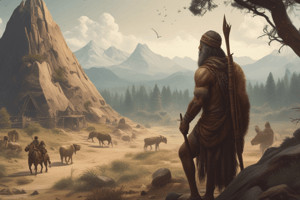Podcast
Questions and Answers
What is the main difference between the economic approach of hunter-gatherer societies and modern industrial societies?
What is the main difference between the economic approach of hunter-gatherer societies and modern industrial societies?
- Hunter-gatherers are more consumption-oriented, while modern societies prioritize production.
- Hunter-gatherers are more concerned with technology, while modern societies focus on environmental costs.
- Hunter-gatherers have few needs easily met, while modern societies continually seek more abundance. (correct)
- Hunter-gatherers focus on material wealth, while modern societies focus on spiritual wealth.
According to Marshall Sahlins, what is the key to achieving affluence?
According to Marshall Sahlins, what is the key to achieving affluence?
- Working hard to purchase more 'labour-saving devices'.
- Mastering the 'zen road to affluence'.
- Having a satisfied state of mind. (correct)
- Having lots of material possessions.
What is the main environmental consequence of the modern industrial world's consumption habits?
What is the main environmental consequence of the modern industrial world's consumption habits?
- Increased production of 'labour-saving devices'.
- Rapid depletion of natural resources.
- Rapid growth of urban populations.
- Unsustainable growth and environmental costs. (correct)
What is the significance of the San people's craft culture?
What is the significance of the San people's craft culture?
What is the author's suggestion for achieving sustainability?
What is the author's suggestion for achieving sustainability?
What is the main driver of the modern industrial world's consumption habits?
What is the main driver of the modern industrial world's consumption habits?
What is the significance of the 'zen road to affluence'?
What is the significance of the 'zen road to affluence'?
What is the main difference between the San people's crafts and modern industrial production?
What is the main difference between the San people's crafts and modern industrial production?
Which materials have been traditionally used by San artists to create jewellery?
Which materials have been traditionally used by San artists to create jewellery?
What new medium have San artists adapted to create a stunning new tradition?
What new medium have San artists adapted to create a stunning new tradition?
What is required for San crafts to generate real value and recognize producers' skills?
What is required for San crafts to generate real value and recognize producers' skills?
What is a significant challenge San artisans face in selling their crafts?
What is a significant challenge San artisans face in selling their crafts?
How are San crafts typically sold?
How are San crafts typically sold?
Why do San artisans tend to be paid little for their work?
Why do San artisans tend to be paid little for their work?
Study Notes
Hunter-Gatherer Economy vs. Modern Industrial World
- Hunter-gatherer societies, like the San, have a form of "primitive affluence" where they are content with few needs easily met, leading to a state of mind defined as affluence.
- In contrast, the modern industrial world has an aspiration-fuelled consumption and production loop, making it difficult to be satisfied with enough.
The "Zen Road to Affluence"
- Marshall Sahlins argues that hunters and gatherers have mastered the "zen road to affluence" by having few needs easily met, leading to satisfaction.
- This concept redefines affluence as a state of mind rather than a material condition.
Environmental Costs and Sustainability
- The modern industrial world's consumption and production loop has obvious environmental costs.
- Many environmental economists argue that we have or will soon reach the limits of growth.
San Craft Culture
- The San people still make crafts for personal expression, gifts, and income generation.
- San artistic tradition is not confined to particular mediums and adapts to new materials and mediums.
- San artisans are imaginative in adapting traditional styles to new mediums, such as using fencing wire, tin cans, and plastic bags to create crafts.
Challenges in Craft Sales
- Crafts can generate cash for impoverished households, but a sustainable infrastructure is needed to access markets.
- Current craft sales are often made through tourist ventures or charitable organisations, which do not generate returns commensurate with the artisans' skill and artistry.
- As a result, San artisans are often underpaid for their labour-intensive and highly-skilled work.
Studying That Suits You
Use AI to generate personalized quizzes and flashcards to suit your learning preferences.
Description
Compare and contrast the economic approaches of hunter-gatherer societies with modern economies, exploring the concept of 'primitive affluence' and the work of Marshall Sahlins.



